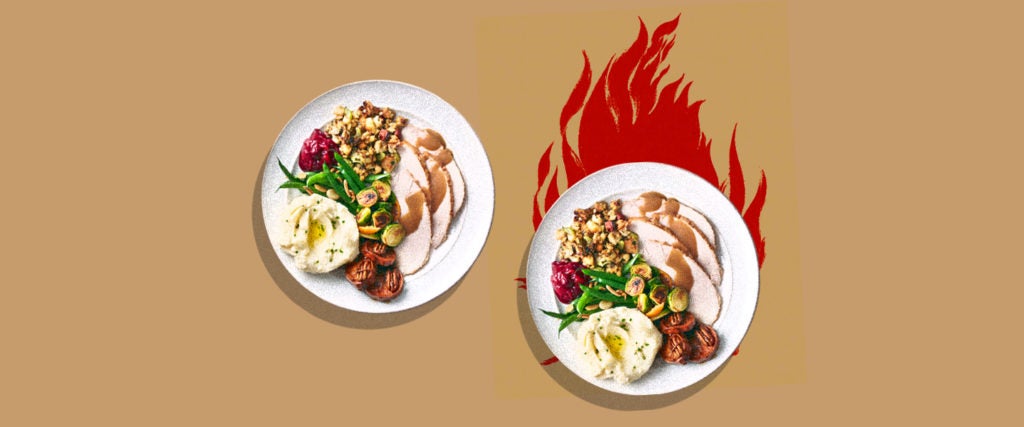In more ways that not, Thanksgiving has been specially engineered to inspire arguments. Its colonialist origins — and the centuries of genocide that followed — will always make for heated dispute. The tricky coordination of meal courses and kitchen access can shorten any temper. And in the back of our minds, we’re panicking that we’ve yet to start gift shopping for the next holiday. Adding insult to all this pressure, we’re supposed to voice our gratitude on the occasion. Gross.
Luckily, from all this morass, I have salvaged the one opinion we can all agree on: The second plate of Thanksgiving food always hits better. It is an uncontestable scientific truth. No exceptions.
“man fuck thanksgiving, racist ass fake holiday” -me as I go back to fill up my second plate
— RAP DAD (@yehme2) November 23, 2017
What is it about the second plate? It feels like the summit of the meal, and therefore the entire day — it is where you push beyond the ordinary business of feeding yourself to achieve a superhuman level of satiety. It shouldn’t really be possible to consume a second plate after taking down the gravy-soaked pile of meat and starch on the first, yet you know it is your duty and fate. The stomach and intestines adapt to another reality: There’s no such thing as “full.”
Me after I finish my first plate on thanksgiving and going for my second plate
— Ozzie (@ozzymarquez16) November 21, 2018
Even if your family or friends serve Thanksgiving dinner around 2 p.m. — and you should — it’s likely that everyone is starving when they take their seats at the dining table. People have skipped breakfast and are trying to resist the hors d’oeuvres, knowing how they’ll gorge themselves in the hours to come. They’ve watched the Pillsbury Doughboy balloon in the Macy’s Day Parade, and licked their lips imagining hot buttered rolls. By the time we sit down and serve ourselves, the appetite is too keen to enjoy. The first plate we eat to survive; the second we eat out of love. The first plate is for politely sampling every dish; the second is favorites only.
when u go back to get ur second plate on thanksgiving and it’s just mac and cheese and yams and they mix together a lil bit and create culinary perfection pic.twitter.com/JovrhTe13U
— that’s rough, buddy (@tamaguccie) October 22, 2020
This is when you can slow down and savor the feast — the crispy edges of the mac and cheese, the slivered almonds with the green beans, the perfect seasoning on the stuffing. Before, you were shoveling it in with virtually no pause for breath, so great was your enthusiasm. Now, you can be civilized. You can speak — and compliment the various cooks — between more sensible bites. The second plate is also a pleasurable mop-up mission. The foods blend together, the recombinant mass is more delicious than any of it in isolation, and you set to the god-given work of sweeping up every last forkful, leaving just the greasy trail of the utensil in your wake.
After ya eat ya second plate on thanksgiving pic.twitter.com/j3GSpoqXAZ
— K$ (@TheKStell) November 27, 2014
For many years, I was ambivalent toward the pies that traditionally follow a Thanksgiving meal, and while my position has evolved somewhat, I still believe strongly that in a philosophical sense, the second dinner plate is the dessert — the best expression of decadence and plenty. We can look forward to a week of cold leftovers, but for the moment, the turkey remains warm and succulent, and the mashed potatoes fluffy as a cloud in heaven. It simply doesn’t get better… particularly as the bloat takes effect within the next few minutes. You’ll spend the rest of the evening in a state of slow-witted repose, as if run over by a 4,000-calorie truck, with barely enough strength to whisper, “Worth it.” Then you pass out, to relive the second plate in dreams.
Me getting my second plate at thanksgiving like I just didn’t eat https://t.co/f1deW9ZVqf
— Tay Electronica✨ (@tayelectronica) November 21, 2020
However, the best proof of the second plate’s divine essence is the way we dance toward it. Despite the frustration and angst of the season, you can’t help but shimmy back to the Thanksgiving buffet for a repeat visit like there’s music in the air. That is what it means to celebrate, and that is why we put up with the rest of the bullshit. It’s a euphoric high that has no name, nor does it ask for one. The second plate is glory unto itself, the triumph of indulgence. You eat it, therefore you are content; you gaze upon its emptied surface and know you are whole at last. Oh, to hold fast to that satisfaction. But it’s not to be. It is temporary, as the best joys always are, so make sure to treasure it while you can. The third plate will not be as kind.

